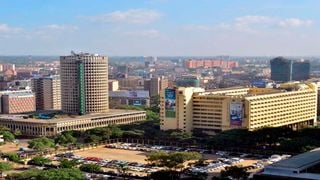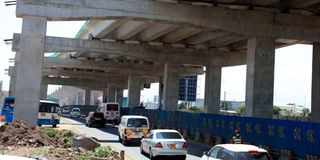
An aerial view of Nairobi City on December 18, 2020.
| File | Nation Media GroupNairobi
Premium
Nairobi, the city turned into one big construction site
That the Machakos County police command has to deploy more than 40 officers every day to control traffic between Mlolongo and Athi River – a nine-kilometre stretch -- on the busy Mombasa Road is testament enough on how bad movement on that section has become.
Each day from sunrise, through the sweltering daytime Machakos heat and dust, officers drawn from across the county line up along the road trying to get the traffic moving until deep in the night.
On some days, County Police Commander Issa Muhamud personally moves along the road to make sure everything is moving.
“There are a lot of vehicles in the morning and in the evening, sometimes up to midnight,” he says.

The ongoing construction of Nairobi Expressway along Mombasa road on this photo taken on April 3, 2021.
The situation between Mlolongo and Athi River is not unique. Over the past one year, a rush by the government to complete grand infrastructure projects before the end of its term has come at a huge cost to Kenyans in urban areas who have to sit in traffic for longer hours.
The Nairobi metropolitan region, especially, almost grinds to a halt during rush hours. Roads that were previously considered a godsend such as Thika road, and some of the bypasses, have become a nightmare for motorists, while the ones notorious for traffic have turned into ‘parking’ lots.
The capital city has become one huge construction site. Everywhere you turn, there is either a road under construction or a pavement being done. However, due to decades of poor planning, Nairobi lacks adequate space for way leaves.
This means that contractors have to either divert traffic to any available road or accommodate motorists while construction is going on. The net effect of all these factors is that driving, which was already too slow before all the construction began, has been made slower.
In August, commuters spent the whole night on two different occasions, stranded on Mombasa Road, as heavy rains and lack of way leaves conspired to keep them on the road.

A Nairobi County employee repairing a section of the pavement on Aga Khan walk.
Nairobi is notorious for its perennial traffic jams, which are estimated to cost the economy upwards of Sh60 billion a day, but sleeping on the road is one of the worst things that can happen to anyone.
“Your abdication of traffic management, starting with the nightmare that is Mombasa Road is criminal at (a) minimum. Zero thought into signage and proper diversions ... Is this a road construction or a deliberate assault on Nairobians?” asked Ms Ory Mwangi.
“Ridiculous that I am getting home at 4am after an 11-hour journey,” tweeted lawyer Pauline Otsyula.
At the centre of the problems facing the motorists who regularly use Mombasa Road is the Nairobi Expressway, a Sh62 billion elevated highway currently under construction from Mlolongo to James Gichuru Road, 27 kilometres away in Westlands.
Marketed as the magic wand that will cure the traffic that has been clogging the busy Highway A109 (Mombasa Road) from the Athi River to the city centre and Highway A104 (Waiyaki Way) up to the James Gichuru Road junction from the city centre, construction of the expressway has become a nightmare for city residents.
A section of the non-motorised transport routes along Nairobi’s Kenyatta Avenue.
“The reason we are constructing the Nairobi Expressway is to solve the traffic jam that was there before. If there was no traffic congestion before, there would be no justification to construct the highway. This pain we are having now is very short-term pain,” Transport Cabinet Secretary James Macharia told the Nation in April when complaints about Mombasa Road started to surface.
Mombasa Road and Waiyaki Way not only cut the capital into two equal geographical sections but also serve as the main transport artery for the country, connecting Mombasa to western Kenya and to neighbouring countries.
Any disruption on the movement of vehicles on these two highways creates a ripple effect on the three main arteries that bring or evacuate traffic from Nairobi -- Thika Superhighway and Lang’ata and Jogoo roads.
Apart from the expressway, several other main roads are currently under construction, which has turned a bad situation worse. Joining the expressway at James Gichuru is a 23-kilometre highway that will run up to Rironi in Kiambu County.
Expansion of the Sh16 billion road began in 2016 and was supposed to be completed last year. In April, a visibly agitated Mr Macharia, while on an inspection tour of the road, gave the contactor, China Wu Yi, an ultimatum to finish the road by July.
“That's not what we agreed on. You told us December 2020, then it was February 2021, then April and now you want December? It can't work like that?” complained the CS.
“I thought we're coming to prepare for the commissioning, but now it cannot be done because you're saying three kilometres are not ready. What we want now is to get a firm commitment that the road will be completed in the next two months,” said the CS.
On the opposite end of the expressway, an expansion of Mombasa Road from Athi River into a dual carriageway up to the Machakos junction has been ongoing for the past four years. The project was launched in 2016 but completion of 20 kilometres has apparently become difficult for the contractor.
Outering Road too, which was opened to the public three years ago, has several incomplete sections. Initially conceived as a game-changer for the eastern part of Nairobi where there is a high population density had led to heavy traffic, the road has had several design afterthoughts.
These afterthoughts include construction of middle lanes, which began sometime in 2019 for Bus Rapid Transit (BRT), but the idea was abandoned, creating a sudden end of lanes. During rush hour, this feature creates a traffic snarl up in some sections, while at night, it is a death trap for speeding motorists who suddenly encounter painted tyres at the end of a lane.
On another part of town, construction of the Western Bypass, which starts at Gitaru, and connects to the Southern Bypass through Wangige, Ndenderu, and terminating at Ruaka, has also not been kind to motorists.
The bypass covers 15.3km on the main carriageway and 17km committed to service roads and is currently halfway done. According to the government, construction is currently at 54 percent. The traffic it creates from Ruaka to Kikuyu, however is a headache.
Despite the lost productivity and time, Mr Macharia said there were losses, even before all the construction began and that “these are the losses we want to mitigate”.
But why would the government, which has created its identity of infrastructure suddenly rush to give the city a facelift in its final months when it had nine years? The Transport CS denies there is a rush.
“The government is continuous, what changes is the administration. We are not looking at five years, what we are looking at is continuous and the needs of the mwananchi, because the constant we have is that mwananchi requires these services,” he said.
Nevertheless, for him and his team, they would still like to finish what they started while in office, he added.
“It is a personal desire of me and my team and we are working as hard as we can. But you can look at what we have in the last nine years, we haven’t stopped and we didn’t start working yesterday because we are stopping next year, so the work is continuous,” said the CS.
From our observation, however, the residents who are suffering the most when they should not have to due to all the ongoing construction are those living close to the Thika Superhighway. With Mombasa Road in a mess, most motorists who should use it are using Outering Road to join the Thika Superhighway in order to access the city centre.
Five years ago, you could drive at free-flow speed from Ruiru to Ngara. Today, you can barely move during rush hour. One of the worst sections is between Pangani and Junction 6 at Survey of Kenya, a distance of 2.5km.
Those living along the 50.2 kilometre highway say it takes up to two-and-a-half hours to get to town from Githurai, a distance of just 16 kilometres. The curfew has worsened the situation as motorists all rush at the same time to get home.
In the morning, traffic begins at Roysambu as early as 6am and sometimes it lasts for five hours. In the evening, it stretches from the city centre to Roysambu, 11 kilometres away. Things get thick in Muthaiga at the section where Kiambu Road – also a traffic nightmare – joins the highway.
Motorists from Kiambu town form long winding queues on the single-lane road, before joining the underpass that leads to the two main tributaries into the city centre.
This has forced thousands to adjust their daily programmes, with many having to leave home before 6am to make it to their places of work on time.





